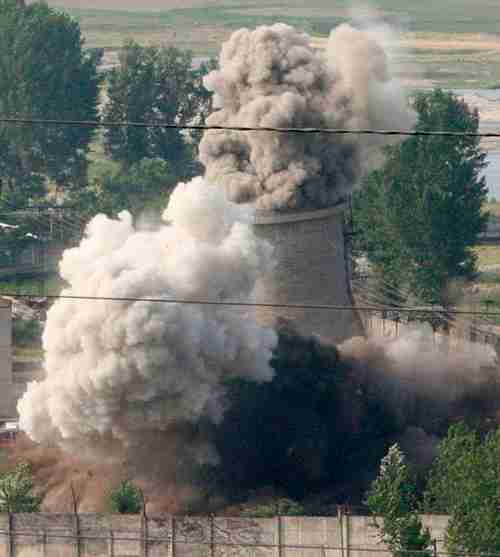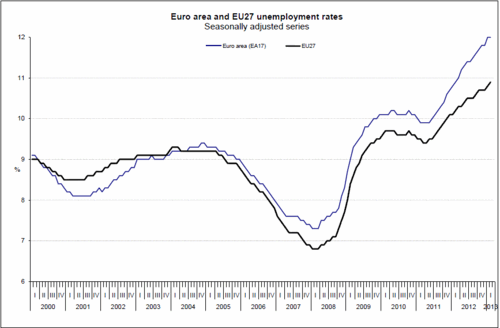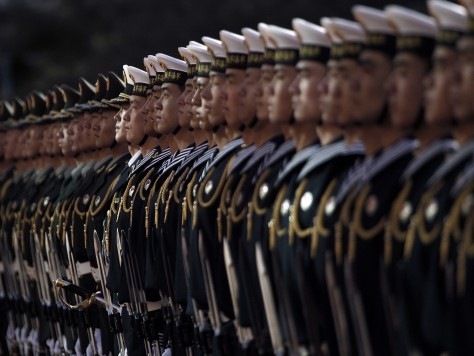
This morning’s key headlines from GenerationalDynamics.com
- North Korea restarting nuclear power plant
- China mobilizing troops, jets, navy near N. Korea
- Eurozone unemployment rises to record high 12%
North Korea restarting nuclear power plant

The N. Koreans spectacularly blew up the Nyongbyon cooling tower on June 27, 2008 (AP)
North Korea announced on Tuesday that it would be restartingits nuclear facilities at Nyongbyon, including theplutonium reactor and a uranium enrichment plant whichproduce fuel for nuclear weapons. In 2007, the NorthKoreans agreed to shut the plant down, in return for economicaid. In 2008, the North Koreans demolished the cooling towerin a spectacular explosion. The new announcement signals thefailure of pretty much the only success in negotiating withNorth Korea in the last decade. AP
China mobilizing troops, jets, navy near N. Korea
The process of ping-pong belligerence continued to grow as threats ofwar on the Korean Peninsula have caused China to place its militaryforces on heightened alert. China’s People’s Liberation Army (PLA) ismobilizing troops near the border with North Korea, including troopmovements and warplane activity. China’s navy warships have also beenconducting live-firing naval drills in the Yellow Sea.
This comes a week after North Korea announced that since March 26 itsmissile and artillery forces have been placed on the highest alertstatus.
It’s not completely clear whether China’s mobilization is for thedefense of China from attacks by North Korea, for the defense of NorthKorea from attacks by the U.S. and South Korea, for the defense ofChina from attacks by the U.S., or for all of the above.
The United States has moved a destroyer capable of shooting downmissiles to the waters off the coast of Korea. Over the weekend, theU.S. flew two B-2 stealth bombers round trip from Missouri to Korea,where dummy bombs were dropped. Many people consider these actions tobe warnings to both North Korea and China that the U.S. is capable ofdelivering nuclear weapons quickly, even without use of aircraftcarriers.
This kind of ping-pong belligerence in a generational Crisis era isexactly the kind of thing that triggers generational crisis wars.Pundits are expressing the hope the N. Korea’s child dictator KimJong-un will back down, allowing the U.S. and China to back down, andcertainly China and his own advisors are pressuring him to do justthat. But he may have gone so far out on a limb that backing down nowwill put his entire dictatorship into danger. Russia Todayand Free Beacon
Eurozone unemployment rises to record high 12%

Eurozone unemployment rate, 2000-2013. Unemployment fell sharply during the giant credit bubble of 2000-2007, and has been rising steadily since the bubble burst. (eurostat)
The unemployment rate rose to a eurozone all-time high of 12% inFebruary, up from 10.9% in February of last year. The hugedivergences within the eurozone were illustrated by youthunemployment, which ranged from 55.7% in Greece to 7.7% in Germany.Compared to a year ago, the highest increases occurred in Greece,Portugal and Spain, while the largest decreases occurred inLatvia, Estonia, and Ireland.
As bad as the figures are, the worse news is that this is a long-termtrend that’s continuing. For several years, we’ve been hearing thatEurope’s economy would start growing again — in 2008, in 2009, in2010, in 2011, in 2012. All of the “kicking the can down the road”European crises, especially in Greece, were based on the assumptionthat if you can stall long enough, then the economy will start growingagain, and everyone can start spending money and going into evenhigher debt — a truly ridiculous assumption, since it assumes thatthe credit bubble will resume. Even now I hear some analysts talkabout growth in the second half of 2013, or in 2014. But the Boomersand Gen-Xers who caused the huge credit bubble of the early 2000s havebeen badly burned by their personal and business debt. This is whathappened in the 1930s, after the crash of 1929, and why the stockmarket didn’t return to pre-crash levels for 25 years. In fact, fromthe point of view of Generational Dynamics, we haven’t even seen theworst yet, because we will see, with absolutely certainty, a historiccrash that will be remembered forever, just as the crash of 1929 isindelibly burned into generational memory. Bloomberg and eurostat (PDF)
Permanent web link to this article
Receive daily World View columns by e-mail

COMMENTS
Please let us know if you're having issues with commenting.